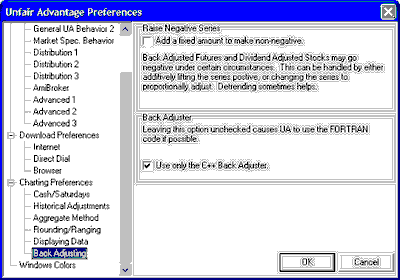The Back-Adjusting screen on UA's Charting Preferences deals with the calculations used in creating back-adjusted futures contracts with UA.

The Back Adjusting screen of Charting Preferences is very similar to the "Back Adjusting" tab of Portfolio Settings. The one that controls your current chart depends upon how the chart is created. Charts made from a portfolio listing use the preferences that are defined for the specific portfolio. Charts made through the "New Chart" feature will use the specification on the Charting Preferences - Cash/Saturdays screen. Either way, here's how the settings apply:
Raise Negative Series
You'll have the opportunity to "Add a fixed amount to make non-negative." This refers to negative values created through the creation of adjusted continuous data files.
Back- and forward-adjusted continuous contracts can regress to negative values into the past. This is one of 3 options allowing you to avoid negative numbers. The resulting data (including current contract prices) will be adjusted upward by the absolute value of the maximum dip below zero rounded up to the nearest 1,000 points. For example, if a PB series gets down to -69.07, then 6907 is rounded up to 7000. The low price of the modified series is then -69.075 + 70.00 = 0.925 which would display as .92.
Versions UA 2.10.8 Build 938 and above no longer round the maximum dip below 0, but instead uses the exact value to
lift all the pricing up by this minimal amount, so that the lowest price of the entire series is exactly 0.0.
Alternately consider using a Ratio(Proportional) Adjusted Contract, which preserves the actual current contract's pricing, or use the detrend option as alternative methods to keep your backadjusted series from going negative ( when necessary for compatibility with other analysis software than can't process negative values ).
Back Adjuster
The lower portion of the Back-Adjusting screen (in Charting Preferences) gives the option of using the C++ Back Adjuster. The "back adjuster" refers to the algorithm used to select contracts in back-adjusted continuous files when rolling on volume and/or open interest is selected. UA offers two methods for back-adjusting data. The original (standard) method is written in FORTRAN and the newer (alternate) method is written in C++.
The writeup about the back-adjuster preference located in the Editing Portfolio Settings chapter of this manual includes an in-depth example with more information about these two choices. A summary of differences between the standard and alternate back adjuster is also included in Bob Pelletier's essay, "Computed Contracts: Their Meaning, Purpose and Application" (see Back-and Forward-Adjusted Contracts) in this manual.

